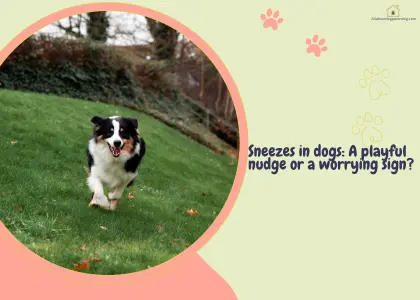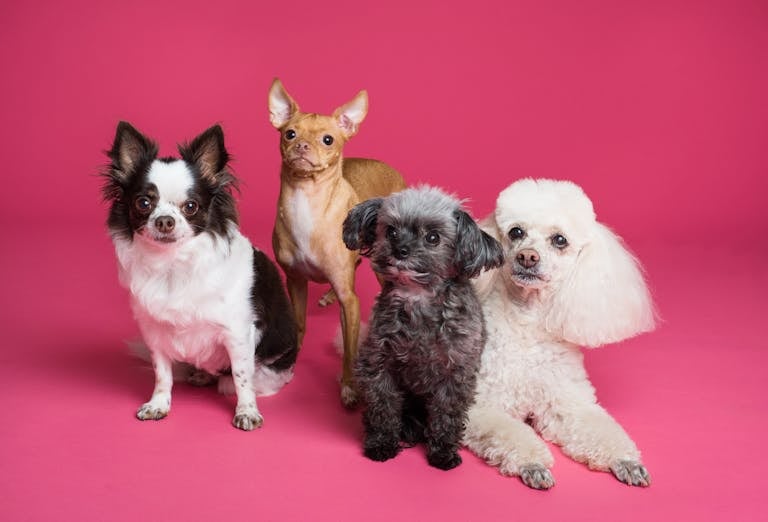Understanding Dog Sneezing Fits: Allergies vs. Play Sneezes
If you’ve been around dogs, you’ve likely seen them erupt into a sneezing fit, usually when they’re sniffing something or mid-play. I’ve seen it with my GSDs all too often. There they are rolling on grass, chasing leaves, or even chasing a toy, and suddenly, they need to pause to sneeze. More often than not, these dog sneezing fits are totally normal. But not always. In some cases, sneezes can be a sign of allergies, nasal irritation, or less commonly, infection.
In this guide, I’ll walk you through why dogs sneeze, how to identify the dog allergies vs play sneezes difference, explore the common triggers, and offer practical tips, based on my own experiences and backed by insights from veterinarians, on what to try and when to seek help.
Why Do Dogs Sneeze?
Typically, a sneeze is a reflex. But the story behind each sneeze can vary. Some sneezes are innocent, others more telling. Understanding this helps you differentiate normal dog sneezing from ones that are brought on by underlying issues.
In most cases, dust, pollen, tiny particles in their nasal passage is what causes dog sneezing. It’s your dog’s way of forcing these irritants out, just like when you breathe in a speck of dust and sneeze. While the response to irritants may be the same, there are certain telling anatomical differences between humans and dogs, such as more sensitive olfactory passages, that make them respond more strongly sometimes.
In addition to these physical reasons, sneezing in dogs can also be a behavioral response. If you notice your sneeze during play time, it’s either a signal of friendliness and happiness, or a request to slow down during rough play.
As long as it’s an occasional occurrence brought on by dust, irritants, or excitement of play time, you have nothing to worry about. But when sneezing episodes repeat often or escalate into fits and you notice dozens of sneezes in a short time, that’s when your ears should perk up. It’s not just what, but how often, when, and with what other signs that matter.
Common Causes of Sneezing Fits in Dogs

Sneezing fits usually originate from a handful of root causes. Some, like play, are benign, others more, like an underlying infection, can be more serious. Knowing the common causes of dog sneezing can help you narrow down what your pup might be reacting to and act accordingly.
- Allergies
Allergies are among the most frequent common dog sneezing fits reasons. Dogs can mount an immune response to pollen, mold, dust mites, or even food proteins. Their nasal passages swell, sensitive membranes get irritated, and sneezing becomes a frequent reflex. Over time, continual exposure keeps the cycle alive. If sneezing is triggered by allergies, you will likely also see other signs such as,
- Itchy skin
- Red eyes
- Excessive licking
2. Play Sneezes
Sneezing is also a part of dog communication and they often use it during play time to tell their companion that intent is friendly, not aggressive. They may also use it to convey that they’re happy with the situation. Or to communicate that they’d like rough play to slow down. All in all, in the behavioral content, sneezes help maintain harmony. These sneezes are short and situational.
3. Environmental Irritants
Dog nasal irritation can also bring about a bout of sneezing, and is often brought on by exposure to elements like:
- Smoke
- Perfume—My GSD can hardly tolerate perfume and sneeze every time I apply it with him around
- Cleaning sprays
- Dust
- Aerosol sprays
- Even, car fresheners
Usually, once the irritant is removed, the sneezes lessen or stop.
4. Nasal Blockages or Infections
Sometimes sneezing fits are a sign of something deeper such as
- A foreign object stuck in a nostril
- Nasal mites
- Fungal or bacterial infections
- Dental-chamber infections that cross into nasal spaces
When such serious dog sneezing fits reasons are involved, you will notice persistent sneezing. It may also be accompanied by colored discharge, blood, or swelling.
“If your dog won’t stop sneezing, take note. Monitor patterns closely. And keep the animal hospital’s phone number handy. Sneezing in dogs can serve as social communication, but persistent sneezes with discharge needs investigation.”
—Dr. Lois Palin, VMD
Allergies vs. Play Sneezes: Key Differences
The difference between allergy sneezing and play sneezes comes down to context and frequency. Play sneezes in dogs usually happen during roughhousing, are quick, and don’t repeat once play ends. They’re your pup’s way of saying, “This is fun, but I’m not being aggressive.” or “I’d like you to slow down, please.”
Dog allergy sneezing, on the other hand, is ongoing. It shows up outside of play, often with watery eyes, itchy skin, or constant licking of paws. Allergies aren’t dangerous in themselves but can make your dog uncomfortable if not managed. If sneezing feels like a daily event and your dog seems uncomfortable, you’re likely dealing with allergies, not play. Pay attention to the following to identify the difference between allergy and play sneeze:
| Differentiating factor | Playful Sneezes | Allergy Sneezes |
| Frequency & Timing | Happens in bursts during activity such wrestling, chasing, zooming. Once play ends, sneezing stops. | Can occur anytime, even at rest or indoors. Often tied to seasonal shifts or persistent exposure. |
| Triggers | Triggered by excitement, physical movement, or interaction with other dogs. | Triggered by environmental agents like pollen, dust mites, mold, or certain food allergens. |
| Accompanying Symptoms | Isolated sneezes. No discharge, no mucus, no lethargy. | Often paired with watery/red eyes, itchy skin, paw licking, and sneezing fits outside of play. |
| Impact on Normal Life | Harmless, lighthearted, and part of canine communication. | Causes ongoing discomfort that can interfere with sleep, appetite, and general well-being if unmanaged. |
The bottom line: play sneezes are fleeting and benign, while dog allergy sneezing is a pattern that demands management. Your observation is the best tool at your disposal to tell the two apart and get timely help.
Symptoms That Require Vet Attention

Most sneezing is benign. But certain red-flag signs demand a veterinarian’s attention. Here’s are some dog respiratory warning signs to watch out for:
- Sneezing is accompanied by colored discharge. It could be yellow, green, or bloody
- Nosebleeds
- Difficulty breathing or wheezing
- Drop in energy levels or appetite
- Pawing or rubbing their nose persistently
- Repeated sneezing fits that don’t subside
- Facial swelling or nose deformities
“If your dog has nasal discharge, bleeding, or isn’t eating, see your veterinarian immediately.”
— Dr. Palin
Home Remedies and Care for Dog Sneezing
Once you’ve ruled out underlying medical issues, you can explore home care for minimizing or preventing dog sneezing. These are supportive dog sneezing remedies, not cures, but they make a difference:
- Reduce Allergens
If you’re wondering how to stop dog sneezing, start with your environment and eliminate triggers. Here are a few things you can try:
- Vacuum carpets, drapes, and soft surfaces often
- Wash dog beds, blankets, and toys weekly in hot water
- Use air purifiers with HEPA filters to trap fine particles
- Keep windows closed during high pollen times
- Use hypoallergenic bedding or covers
- Gentle Nose Cleaning
Another simple dog allergy care is to help clear irritants gently. Use vet-approved saline sprays or drops, apply using a soft bulb or pipette. Wipe nasal openings softly with pet-safe, damp gauze or wipes after walks. But don’t overdo it. Excess cleaning can irritate your pet’s nasal tract further.
- Safe Play
Play sneezes are okay, so let them have fun. But avoid overly dusty outdoor areas, smoky zones, or using sprays near play zones. Monitor rough play to ensure it doesn’t worsen irritation.
- Avoid DIY Mistakes
Don’t use essential oils, strong herbal blends, or human OTC sprays near the dog. And never use these as dog sneezing remedies. These natural remedies are irritating or toxic to nasal tissues. Human allergy meds like antihistamines, decongestants should never be given without a veterinary prescription.
Preventing Sneezing Fits in Dogs

The more you reduce risk and maintain health, the fewer sneezing episodes your dog is likely to suffer. These simple measures go a long way in preventing dog sneezing:
- Groom your dog regularly to remove pollen, dust, and debris trapped in the coat
- Use a diet that supports immune health
- Keep strong scents, smoke, and chemicals away
- Make sure your dog is on year-round flea/tick protection, especially if they have allergies, since flea bite allergies can worsen nasal symptoms
“It is crucial to keep your pet on flea and tick prevention year-round. Preventing exposure to as many allergens as possible also decreases overall symptoms.”
— Dr. Palin
FAQs About Dog Sneezing Fits
1. Why do dogs sneeze during play?
Dogs often sneeze in the middle of play as a social communication tool, not because of irritation. Dogs sneeze during play or social interactions as a way to signal their intentions. These “play sneezes” signal excitement and let the other dog know, “I’m being playful, not aggressive.” These are harmless, short-lived, and context-specific.
2. Can allergies really be behind sneezing in dogs?
Yes, allergies are a very common cause of dog sneezing fits. Inhaled allergens like pollen, dust mites, and mold can irritate the nasal passages, leading to repeated sneezing episodes. Food sensitivities may also play a role. Veterinarians often recommend allergy testing if sneezing is frequent and comes with itchy skin, watery eyes, or paw licking, since these are strong indicators of an underlying allergy response.
3. When should sneezing concern me?
A few sneezes now and then are nothing to worry about, but sneezing becomes a concern when it’s frequent, violent, or paired with other symptoms. You should see a professional if your dog’s sneezing is accompanied by colored or bloody discharge, breathing difficulties, appetite loss, or lethargy. These could signal infections, blockages, or more serious respiratory conditions needing prompt care.
4. Are certain breeds more sneezy than others?
Yes, some breeds are simply more prone to sneezing because of their anatomy. Brachycephalic breeds like Pugs, Bulldogs, and Boston Terriers have shortened nasal passages and compressed facial structures, which make them more sensitive to irritants. This can also predispose them to respiratory infections or airway inflammation, meaning their sneezes are not always playful or harmless, but sometimes medical.
5. Can cleaning the home really reduce sneezing?
Yes, maintaining a clean home can make a big difference. Reducing dust, washing your dog’s bedding weekly, and running an air purifier all cut down on common irritants. Avoiding perfumes, smoke, or strong cleaning sprays also helps. Many pet parents notice sneezing episodes ease dramatically when allergens in the environment are minimized, which makes home hygiene a simple yet effective form of dog allergy care.
Takeaway
Most dog sneezes are harmless, especially if they only happen during play or sniffing. Play sneezes are just part of your dog’s friendly body language. But if sneezing gets heavy, persistent or comes with other symptoms, treat it like an alert and step up your dog sneezing care. The right home care and preventive measures such as reducing triggers, using vet-recommended remedies, and following your vet’s dog allergy tips, go a long way in managing sneezing episodes. But if you feel something’s off, always err on the side of caution. Remember, a quick vet call can save you a lot of worry and your pet a lot of discomfort.







